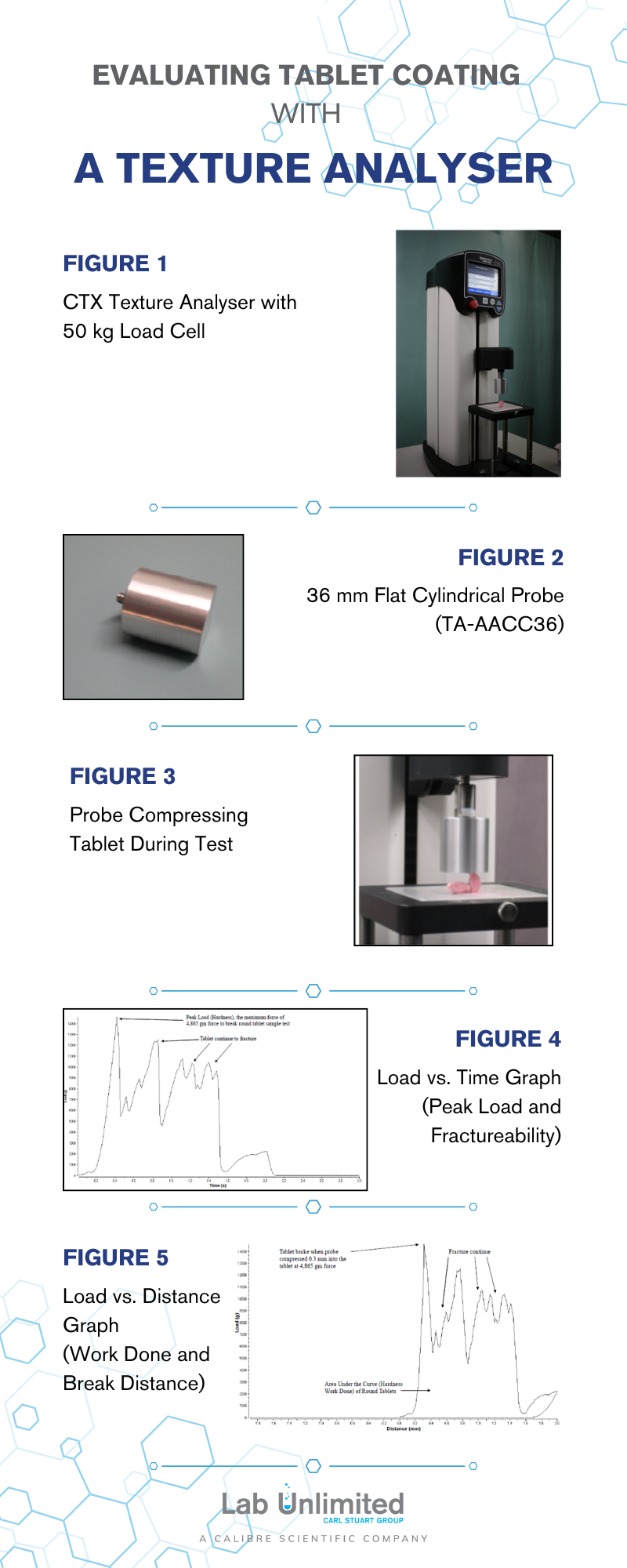
Evaluating Tablet Coating with a Texture Analyser
Texture analysis is a vital tool in maintaining uniformity in tablet design, enhancing textural characteristics, safeguarding tablet integrity during manufacturing and distribution, and understanding the consumer or patient experience—whether swallowing or chewing. The CTX Texture Analyser demonstrates exceptional versatility in research and development (R&D) laboratories by providing accurate measurements of physical tablet properties (Figure 1). In Quality Control (QC), simplified texture tests help confirm that manufacturing processes adhere to R&D standards.
Modern texture analysers like the CTX offer both advanced PC-controlled tests for R&D and efficient, single-point assessments for standalone QC use—without requiring a computer.
Crushing Test for Tablet Strength
Tablets are a cornerstone of pharmaceutical delivery, but they must endure significant mechanical stress during production, packaging, distribution, and final handling—all while ensuring reliable drug release. Evaluating their mechanical strength is essential.
Using the CTX Texture Analyser in compression mode, a crushing test is performed to measure the force required to break a tablet. The tablet is positioned upright on a fixture base table and compressed using a 36 mm flat cylindrical probe (TA-AACC36) (Figure 2).
Method and Settings
Equipment:
- CTX Texture Analyser with 50 kg load cell (Figure 1)
- Flat cylindrical probe, 36 mm diameter (TA-AACC36) (Figure 2)
- Fixture base table (TA-BT-KIT)
- TexturePro Software
Test Parameters:
- Pre-test speed: 2 mm/s
- Test speed: 1 mm/s
- Target deformation: 2 mm
- Trigger load: 30 g
- Target type: Distance
Once the trigger load is reached, the probe compresses the tablet until a deformation of 2 mm is achieved. The analyser records the Peak Load, indicating the hardness of the tablet. The moment of probe compression during the test is captured in Figure 3.
Results and Graphs
The test results are visualised in two key graphs: the Load vs. Time graph (Figure 4), which reveals the Peak Load and point of initial fracture, and the Load vs. Distance graph (Figure 5), which displays the total energy (work done) and distance at which the tablet breaks.
In this trial, tablets achieved a peak load of 4,865 grams, with fracture occurring when the probe penetrated 0.3 mm. The TexturePro Software automatically calculated the average values and standard deviations across multiple samples, simplifying data reporting and boosting repeatability.
Tablet coatings serve a vital purpose: enhancing taste, protecting the active ingredients from moisture, aiding in swallowability, and controlling drug release. The strength of the coating's adhesion is critical—poor adhesion can lead to peeling or delamination, risking the drug’s stability and efficacy.
The CTX Texture Analyser is also used to evaluate coating adhesion through a method involving an adhesion fixture with contoured cylinders and double-sided tape.
Test Method
- The tablet is fixed between the two cylinders using adhesive tape.
- In compression mode, the coating is bonded to the tape.
- In tension mode, the cylinders are pulled apart at 1.0 mm/sec, peeling the coating from the tablet surface.
This method provides precise data on the adhesive strength of the coating.
Results
- Compression forces typically exceeded 1,500 grams
- Tension forces required to peel the coating ranged from 250 to 700 grams
The TexturePro Software calculates averages and standard deviations automatically, enabling consistent QC evaluations across batches and highlighting potential coating performance issues early.
For further insights and visual guidance, we encourage you to explore the Brookfield CTX Instructional Video: Tablet Coating.
In Summary
Incorporating the Crush Test and Coating Adhesion Test into tablet manufacturing processes enables consistent production of high-quality products that meet consumer expectations. The time required to perform these tests is insignificant compared to the potential customer service time needed to address complaints about tablet integrity. Moreover, the investment in equipment for these tests is well below €10,000, and the training time required to set up and run the tests is likely no more than an hour. Therefore, it is worth considering how Texture Analysers can enhance Quality Control in tablet manufacturing, ultimately improving the bottom line.
Discover how Texture Analysers can enhance your Quality Control in tablet manufacturing. Learn more about our Texture Analysers at Lab Unlimited.
|
To Find Out More: |

